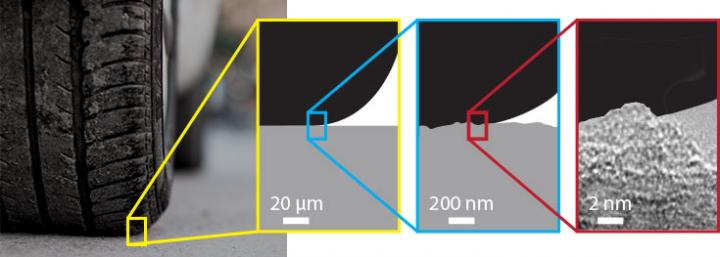New research finds missing link between soft surface adhesion and surface roughness

Credit: University of Akron College of Polymer Science and Polymer Engineering
PITTSBURGH (Dec. 2, 2019) — Tires gripping the road. Nonslip shoes preventing falls. A hand picking up a pen. A gecko climbing a wall.
All these things depend on a soft surface adhering to and releasing from a hard surface, a common yet incompletely understood interaction. New research published in Proceedings of the National Academy of Sciences (PNAS) finds the missing link between soft surface adhesion and the roughness of the hard surface it touches. The paper, “Linking energy loss in soft adhesion to surface roughness,” (DOI: 10.1073/pnas.1913126116) was published in Proceedings of the National Academy of Sciences and was coauthored by Siddhesh Dalvi, Abhijeet Gujrati, Subarna R. Khanal, Lars Pastewka, Ali Dhinojwala, and Tevis D.B. Jacobs.
Dr. Jacobs, assistant professor of mechanical engineering and materials science at the University of Pittsburgh’s Swanson School of Engineering, and Dr. Dhinojwala, interim dean and H.A. Morton Professor of Polymer Science at The University of Akron’s College of Polymer Science and Polymer Engineering, have used in situ microscopic measurements of contact size to unlock the fundamental physics of how roughness affects soft material adhesion.
“A gecko running up a vertical wall is an excellent example of how nature has developed a solution to stick to rough surfaces,” says Dhinojwala. “The key to achieve this adhesion on rough surface is molecular contact. Soft material can conform to rough surfaces and create the molecular contact necessary to stick well. We need a fundamental understanding of the parameters that control adhesion to rough surfaces and the underlying physics.”
There are two different parts of the process: what happens when you load up the contact and what happens when you separate it.
Previous theories have proposed how roughness affects the first half of the process, but offer no insight into the second half. This problem is called “adhesion hysteresis,” meaning the soft surface contact behaves differently as it encounters the rough surface rather than when pulled away. One way to think about adhesion hysteresis is to think of a small rubber ball. Pressing the ball down against a hard surface expands the area of contact; letting go will cause the area to shrink again, but not in a predictable, symmetrical way. This discovery marks the first model of rough adhesion that can predict both.
The key to this foundational discovery is a close look at the rough surface itself–very, very close.
“People have been measuring roughness for a hundred years, but conventional techniques can’t see the small detail,” says Jacobs. “We zoomed in, combining multiple techniques, to measure roughness on top of roughness on top of roughness. The texture goes down to the atomic scale for many surfaces.”
The group developed a new approach using an electron microscope to measure roughness down to below the scale of a nanometer. One of the surfaces in this study appeared far smoother than two others when measured using conventional techniques; however, when measured down to the atomic scale, it proved to be the roughest of all. This small-scale roughness created a lot more surface area for the soft material to grip. The detailed understanding of the rough surface was the missing link that explained the predicted the surfaces’ adhesion behavior.
“Our research answered an important question, but in another sense, it opened up a new line of inquiry,” says Jacobs. “There are a lot of interesting questions about what it really means for surfaces to be ‘in contact’ and how to link what is happening at the atomic-scale to what we observe in full-size, real-world contacts. And we’re excited to continue answering them.”
###
Media Contact
Maggie Pavlick
[email protected]
412-383-0449
Original Source
https:/
Related Journal Article
http://dx.




